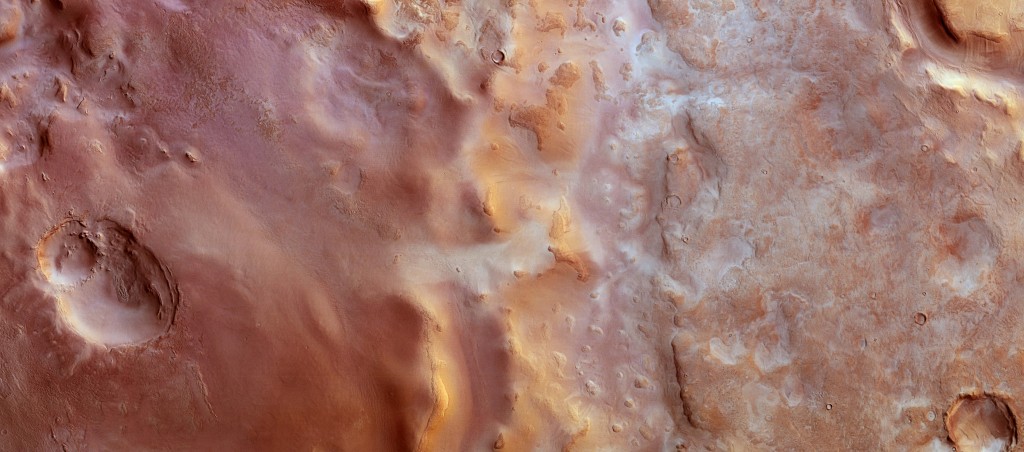Following its arrival at the Red Planet in December 2003, imagery from ESA’s Mars Express mission has proved immensely popular, with the High Resolution Stereo Camera (HRSC) on board the spacecraft playing a major role.
Since January 2004, ESA and its partners at the German Aerospace Center (DLR) and the Freie Universität Berlin (FUB) have been jointly publishing colour, stereo pictures of the martian surface from orbit, both still and moving. For example, a “Mars showcase” video, comprised of HRSC images, has been viewed almost 700,000 times since it was published on ESA’s Youtube channel in 2013.
But starting today, something is different with these regular image releases: in a joint undertaking by all three partners, Mars Express HRSC images will be made available under a Creative Commons (CC) licence. The licence we will apply is the same one we recently introduced for Rosetta NAVCAM images: CC BY-SA IGO 3.0, with credit to ESA/DLR/FU Berlin. In practical terms it will look like this:

Hellas Chaos on Mars. Image Credit: ESA/DLR/FU Berlin, CC BY-SA 3.0 IGO
And as luck would have it, we have a Mars Express HRSC movie release today which becomes the first to be covered by this Creative Commons licence:
Please read the full article on the ESA web portal here.
The licence will also be applied retroactively to all HRSC images released to date. As with Rosetta NAVCAM images, please bear with us as it will take a while to go back and change the credit lines for all of those images in our online galleries. But as a start, we have applied the new licencing to all HRSC images in our Mars Express Flickr album.
While at ESA we have only just begun releasing content under Creative Commons licences, our partners at DLR have been using CC as their standard licencing policy since 2012. Nevertheless, there is still something just a little bit special about the news today: as far as we know, it is the first time that three public organisations in Europe have teamed up in licencing a batch of joint content under Creative Commons.
For more in-depth info on ESA’s implementation of the CC BY-SA 3.0 IGO licence, please also read this blog post that I wrote with my colleague Mark McCaughrean.
Marco Trovatello is the Strategy Advisor and Cross-Media Coordinator for ESA’s Communication Department. Follow him on Twitter at @marco_t.

Discussion: 4 comments
Thank you for releasing these lovely images under a free license. We editors at the various Wikipedia and Wikimedia sites will put them to good use. Any images uploaded to the Wikimedia Commons should be sorted into https://commons.wikimedia.org/wiki/Category:Photos_taken_by_Mars_Express .
I love the 3D images from Mars Express, especially those which are made for 3D view with colored glasses. But I have one wish: I would like to view the 3D images on a real 3D display e.g. on a 3D TV screen or on my smartphone. For this one needs just the left and right image in original color – no need for any color processing like for the colored glasses view. Usually the left and right image are combined to one file of the *.mpo type (= multi picture object), which is very easy with free image processing programmes. So please could you release either both images (left and right) or already the combination. The advantge would be a 3D view in real color and not in grey/red/green.
Thanks for your comment. We’ll discuss with the team and get back to you.
@BetaBob, thanks for your feedback, we are happy to hear that you like our images.
Separate full-colour channels for stereo-display are not available, as HRSC collects grayscale scan images at different angles of the surface: there are no right RGB and left RGB channels but there is a full-resolution grayscale forward-looking stereo channel and a grayscale backward-looking stereo channel.
In order to display these stereo views properly we can provide either grayscale anaglyphs (for glasses) or separate grayscale stereo channels (for shutter/flicker systems).
RGB channels are only used for ortho-image display based on digital terrain models that were calculated from the stereo channels.
However, there are some releases with artificially rendered colour-stereo views which make use of the stereo model.
Thus, if you want to look at all the fine details you have to look at the original stereo channels presented as epipolar/anaglyph images. If you want to have artificial stereo renderings in colour, you need to reduce resolution.
We released some of these in the past as examples, e.g. in grayscale but as oblique surface views:
https://www.esa.int/spaceinimages/Images/2005/06/3D_perspective_view_of_Coprates_Chasma_and_Catena_-_looking_north
https://www.planet.geo.fu-berlin.de/eng/projects/mars/hrsc191-CopratesChasma.php
Or, e.g., as stereo movies in full-colour anagylphs:
https://www.esa.int/spaceinvideos/Videos/2014/10/3D_flight_over_chaotic_terrain
https://www.geo.fu-berlin.de/en/geol/fachrichtungen/planet/press/hydraotes1
There are more examples you can find in the archives at ESA. DLR or FU Berlin .
If you want to learn more about how the camera works in detail, you can take a look at the freely available ESA Special Publication SP 1240:
https://sci.esa.int/mars-express/34885-esa-sp-1240-mars-express-the-scientific-payload